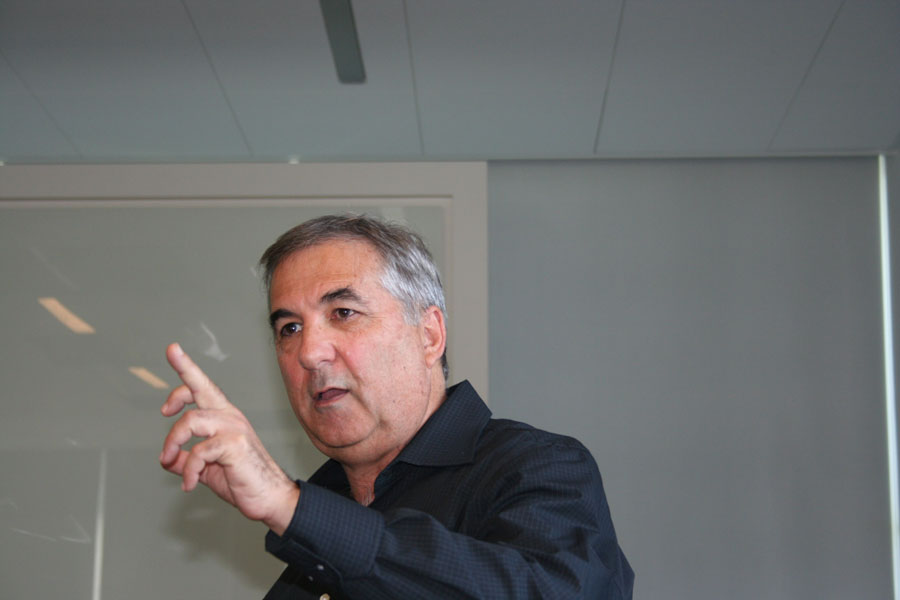On Thursday September 17, 2009, there will be a Stieltjes afternoon at Tilburg University organized by the Thomas Stieltjes Institute for Mathematics.
You are kindly invited to attend.
During the meeting there will be talks by Aharon Ben-Tal, Stieltjes professor 2009, Hermen Jan Hupkes, winner of the Stieltjes prize 2008, and Etienne de Klerk. The Rector of Tilburg University will present the prize.
PROGRAMME
(registration, see below)
13.30 - 14.00
WELCOME (coffee and tea)

14:00 - 14:45
Prof.dr. Aharon Ben-Tal, Technion, Haifa, Israel
"Some remedies for some intractable optimization problems"

14:45 - 15:30
Prof.dr. Etienne de Klerk, Tilburg University
"Recent advances in solving large, structured semidefinite programs"
15.30 - 16.00
BREAK (coffee and tea)
16.00 -- 16:45
Dr. Hermen Jan Hupkes, Brown University, Providence, U.S.A.
"Lin's method and homoclinic bifurcations for functional differential equations of mixed type"
16.45-17.00
Laudatio by Prof.dr. Willem van Zwet (Chairman Stieltjes Prize committee)
Presentation of the Stieltjes Ph.D.-student prize by Prof.dr. Philip Eijlander, Rector Magnificus Tilburg University
17:00 --18:00
DRINKS
Location:
CentER seminar room K 834
Koopmans-building
Tilburg University
Warandelaan 2
5037 AB Tilburg
Registration
If you would like to attend the Stieltjes afternoon you can send an
e-mail to Jolanda
Schellekens-Bakhuis.
Directions to Tilburg
University
ABSTRACTS
"Some remedies for some intractable optimization problems" (Aharon Ben-Tal)
The need to solve real-life optimization problems poses frequently a severe challenge, as the underlying mathematical programs threaten to be intractable.
The intractability can be attributed to any of the following properties: large dimensionality of the design dimension; lack of convexity; parameters
affected by uncertainty. In problems of designing optimal mechanical structures (truss topology design, shape design, free material optimization) the
mathematical programs typically have hundreds of thousands of variables, a fact which rules out the use of advanced modern solution methods, such as
Interior Point methods. Some Signal Processing and Estimation problems may result in non-convex formulations. In the wide area of optimization under
uncertainty, some classical approaches, such as chance (probabilistic) constraints, give rise to non-convex NP-hard problems. Non-convexity also occurs in
some Robust Control problems.
For all the above applications we explain how the difficulties were resolved. In some cases this was achieved by mathematical analysis, which converted the
problems (or its dual) to a tractable convex program. In other cases novel approximation schemes for probability inequalities were used. In the case of huge-scale
convex programs, novel algorithms were employed. In the Robust Control example, a reparameterization scheme is developed under which the problem is converted to a
tractable deterministic convex program.
"Recent advances in solving large, structured semidefinite programs" (Etienne de Klerk)
Semidefinite Programming (SDP) may be seen as a generalization of Linear Programming (LP). In particular, one may extend interior point algorithms for LP to SDP, but it has proven much more difficult to exploit structure in the
SDP data during computation. We survey three types of special structures in SDP data:
- A common "chordal" sparsity pattern of all the data matrices. This structure arises in applications in graph theory, and may also be used to deal with more general sparsity patterns in a heuristic
way.
- Low rank of all the data matrices. This structure is common in SDP relaxations of combinatorial optimization problems, and SDP approximations of polynomial optimization problems.
- The situation where the data matrices are invariant under the action of a permutation group, or, more generally, where the data matrices belong to a low dimensional matrix algebra. Such problems arise in truss topology
optimization, coding theory, computational geometry, and graph theory.
We will give an overview of existing techniques to exploit these structures.
"Lin's method and homoclinic bifurcations for functional differential equations of mixed type" (Hermen Jan Hupkes)
Recently, differential equations involving both delayed and advanced arguments
have appeared in an increasing number of models, originating from a wide variety of scientific disciplines.
We present recent theoretical and numerical results concerning bifurcations from homoclinic and periodic solutions to such equations.
In particular, we show how Lin's method can still be used in the infinite dimensional setting of MFDEs.
|





